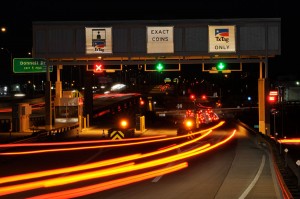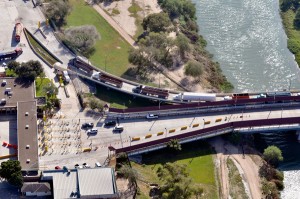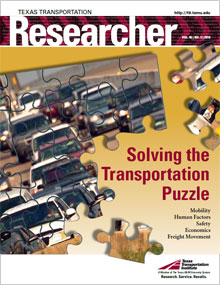
Money makes the world go ’round. In the classic 1873 Jules Verne novel, Around the World in Eighty Days, Phileas Fogg races the clock, traveling by boat, rail, hot-air balloon, stage coach and elephant in hopes of winning £20,000. Today’s rapidly changing technology is making virtual world travel an everyday occurrence. But as long as real people and goods have to get to real places, transportation will play a vital role in global economics.
“You have to look at economics in a broader perspective because things seemingly unconnected to transportation actually have a great impact on it,” says David Ellis, research scientist with the Texas Transportation Institute (TTI). “Looking at things from a system view, you can understand how many components impact each other.”
The systems perspective requires a breadth of expertise — from rail, ports, airports and trucking to infrastructure and financing. At the macro-economic level, whole business sectors depend on maintaining their transportation relationships to remain competitive. A current TTI project is helping a soybean trade association forecast future importing and exporting cost increases due to added U.S infrastructure costs and the financing involved. The goal is to determine how increased transportation costs will impact the ability to compete internationally.
Reducing travel times for commercial vehicles at U.S./Mexico border crossings could have a significant economic impact on both countries. TTI researchers are developing a border-crossing traffic simulation model to measure traffic movement during lane closures and other incidents, examining advanced technologies that provide real-time information on crossing times and delays and analyzing freight flows at different crossings. These activities also consider policy makers’ concerns with border security.
Assessing the benefits and costs associated with transportation projects is becoming more important with federal stimulus programs and other economic development efforts. Construction costs are easy to add up, and benefits like reduction in crashes or fatalities are relatively easy to measure. However, categorizing and quantifying other benefits associated with such factors as livability, sustainability or economic competitiveness are much more difficult, as is linking benefit-cost analyses (BCAs) to established performance measures.

“Measuring livability and global competitiveness benefits are important,” notes Katie Turnbull, executive associate agency director for TTI and director of the Institute’s Transportation Economics Center. “The center provides opportunities for research and outreach on enhancing BCA to incorporate these and other topics.” The center recently assisted the U.S. Department of Transportation in hosting a best-practices workshop for conducting BCAs, enabling experts to share lessons learned.
Budget shortfalls often prevent transportation projects from going forward. When the Interstate Highway System first began, the gas tax — charged as cents per gallon sold, not by the price of a gallon of gas — was proposed as the best proxy user-based fee. But recent technological advancements save motorists money at the pump as vehicles become more fuel efficient and alternatively powered vehicles become more popular. As the amount of gas consumed slowly drops, the gas tax revenue decreases with it. Since most Texas highway construction and maintenance money comes from this source, a major funding problem looms on the horizon. Compounding the problem is the rising price of roadway construction.
TTI researchers see an economic perfect storm on the horizon. “The gas tax has been so invisible, most motorists don’t know there’s a problem,” says Ginger Goodin, senior research engineer. “We’re looking at what could happen in 20 years. Now is the time to start testing solutions.”
Goodin’s team is researching new funding options to consider, such as a fee based on mileage and congestion pricing strategies. TTI is also currently evaluating congestion pricing around the country and helping other states become proactive in using managed lanes.
From funding mechanisms to infrastructure design to border security, TTI researchers are seeking innovative answers to the age-old question: How do we pay for this?
Commentary on Economics
Jack Wells
Chief Economist
U.S. Department of Transportation
When you boil it down, economics is the study of getting progressively better output from a given input. That concept is central to transportation today — resources are limited, demand is growing, and capacity is increasingly inadequate. So the question becomes, how do we get more bang for our transportation buck?
Our transportation system faces several key problems. Congestion is one of these — the Texas Transportation Institute’s (TTI‘s) series of Urban Mobility Reports has documented the growing extent and intensity of this problem.
A second key problem is clarifying what objectives we want transportation to serve. For years, the primary goal of the transportation system has been simply “mobility” — as if the purpose of transportation is, simply, transportation. The Obama Administration is trying to articulate more clearly that we don’t want mobility for its own sake, but to advance goals like economic competitiveness and livability. A third key problem is how to pay for all the investment in transportation infrastructure that is needed. A fourth key problem is how to select the best transportation projects in which to invest our limited supply of investment funds. The Obama Administration is pushing for expanded use of economic analysis techniques — including benefit-cost analysis, cost-effectiveness analysis, and asset management techniques — to inform the project-selection process.
The U.S. Department of Transportation (U.S. DOT) recently created the Transportation Economics Center at TTI to mobilize the resources of the transportation economics community nationwide and bring them to bear on the key policy problems that U.S. DOT is trying to solve. For example, one key issue in measuring the benefits of alternative transportation projects is measuring the value of the time saved in transporting people and goods.
We have reasonably good measures of the value of passenger time, but we have little in the way of measures of the value to shippers of reducing the time (and increasing the reliability) involved in moving freight to its destination. We need better research on this and other key transportation policy questions. TTI‘s strong background in transportation policy research makes it well suited to bring together the work of transportation economics researchers nationwide.
